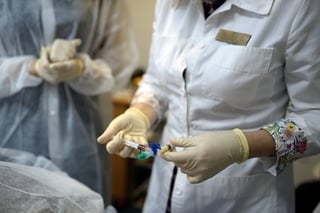Share this
the future of blood specimen collection
by Neoteryx Microsampling on Apr 14, 2017 6:46:00 AM
 In most minds, the concept of “blood work” conjures up an image of a long needle, a search for a prospective vein, a slightly painful entry, and a ~30-second wait until the proper volume of whole blood is extracted. The blood is either analyzed immediately or is placed in a refrigerator until a technician can perform an analysis at some future time.
In most minds, the concept of “blood work” conjures up an image of a long needle, a search for a prospective vein, a slightly painful entry, and a ~30-second wait until the proper volume of whole blood is extracted. The blood is either analyzed immediately or is placed in a refrigerator until a technician can perform an analysis at some future time.
In most cases, the patient must travel to a clinic, hospital, or doctor’s office to have the bulk blood specimen drawn. The experience can be time-consuming and stressful.
If samples are taken in a remote locale, the material must undergo complicated packaging, surrounded by dry ice, and labeled according to shipper’s instructions. The outer case must be marked as a hazardous material and, therefore, requires special handling by the carrier.
What is Microsampling?
Microsampling means extracting a small, fixed amount of blood or other biological fluid. This new method achieves higher levels of accuracy than the Dried Blood Samples (DBS) that have been useful as an alternative to traditional whole blood sampling.
With minimal training, microsamples may be self-drawn by patients at their home, offering the opportunity of remote specimen collection to countless industry applications. Using a specially-designed Mitra™ Microsampler Patients in remote areas may submit the blood samples in the Mitra Microsampler from locations where clinics and hospitals are simply too far away for easy access.
Why Does Microsampling Matter?
Microsampling offers many benefits over the traditional bulky and fragile liquid blood sampling procedure. Some of these benefits are:
- It's minimally invasive, which reduces patient stress.
- Donors who are not able to come to a clinic, hospital, or office regularly can submit samples more easily. As a result, health irregularities can be diagnosed sooner, and treatment can be prescribed. Doctors can continually monitor progress.
- For patients with existing conditions, repetitive visits to the doctor or clinic to draw blood samples may not be required.
- The cost of sending smaller dried specimens by mail or courier is far less than with liquid blood samples.
Additionally, healthcare facilities, resources, and personnel are less taxed with routine functions and may focus on other essential activities.
Share this
- Microsampling (206)
- Research, Remote Research (119)
- Venipuncture Alternative (105)
- Clinical Trials, Clinical Research (83)
- Mitra® Device (73)
- Therapeutic Drug Monitoring, TDM (51)
- Dried Blood Spot, DBS (39)
- Biomonitoring, Health, Wellness (30)
- Infectious Disease, Vaccines, COVID-19 (24)
- Blood Microsampling, Serology (23)
- Omics, Multi-Omics (21)
- Decentralized Clinical Trial (DCT) (20)
- Specimen Collection (18)
- Toxicology, Doping, Drug/Alcohol Monitoring, PEth (17)
- Skin Microsampling, Microbiopsy (14)
- hemaPEN® Device (13)
- Preclinical Research, Animal Studies (12)
- Pharmaceuticals, Drug Development (9)
- Harpera Device (7)
- Industry News, Microsampling News (5)
- Antibodies, MAbs (3)
- Company Press Release, Product Press Release (3)
- Environmental Toxins, Exposures (1)
- July 2025 (1)
- May 2025 (1)
- April 2025 (2)
- December 2024 (2)
- November 2024 (1)
- October 2024 (3)
- September 2024 (1)
- June 2024 (1)
- May 2024 (1)
- April 2024 (4)
- March 2024 (1)
- February 2024 (2)
- January 2024 (4)
- December 2023 (3)
- November 2023 (3)
- October 2023 (3)
- September 2023 (3)
- July 2023 (3)
- June 2023 (2)
- April 2023 (2)
- March 2023 (2)
- February 2023 (2)
- January 2023 (3)
- December 2022 (2)
- November 2022 (3)
- October 2022 (4)
- September 2022 (3)
- August 2022 (5)
- July 2022 (2)
- June 2022 (2)
- May 2022 (4)
- April 2022 (3)
- March 2022 (3)
- February 2022 (4)
- January 2022 (5)
- December 2021 (3)
- November 2021 (5)
- October 2021 (3)
- September 2021 (3)
- August 2021 (4)
- July 2021 (4)
- June 2021 (4)
- May 2021 (4)
- April 2021 (3)
- March 2021 (5)
- February 2021 (4)
- January 2021 (4)
- December 2020 (3)
- November 2020 (5)
- October 2020 (4)
- September 2020 (3)
- August 2020 (3)
- July 2020 (6)
- June 2020 (4)
- May 2020 (4)
- April 2020 (3)
- March 2020 (6)
- February 2020 (3)
- January 2020 (4)
- December 2019 (5)
- November 2019 (4)
- October 2019 (2)
- September 2019 (4)
- August 2019 (4)
- July 2019 (3)
- June 2019 (7)
- May 2019 (6)
- April 2019 (5)
- March 2019 (6)
- February 2019 (5)
- January 2019 (8)
- December 2018 (3)
- November 2018 (4)
- October 2018 (7)
- September 2018 (6)
- August 2018 (5)
- July 2018 (8)
- June 2018 (6)
- May 2018 (5)
- April 2018 (6)
- March 2018 (4)
- February 2018 (6)
- January 2018 (4)
- December 2017 (2)
- November 2017 (3)
- October 2017 (2)
- September 2017 (4)
- August 2017 (2)
- July 2017 (4)
- June 2017 (5)
- May 2017 (6)
- April 2017 (6)
- March 2017 (5)
- February 2017 (4)
- January 2017 (1)
- July 2016 (3)
- May 2016 (1)
- April 2016 (2)



Comments (1)